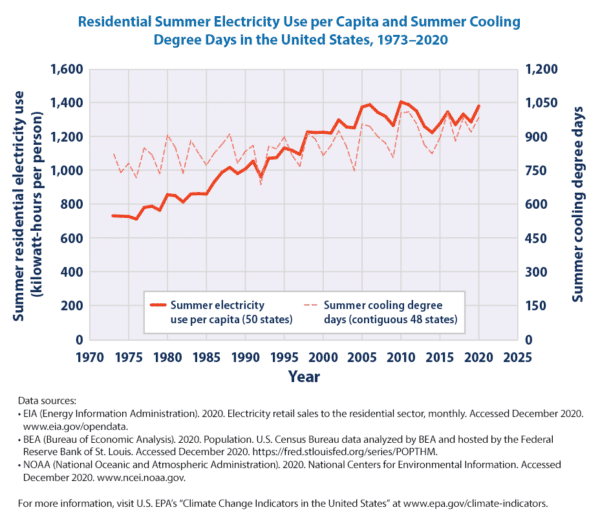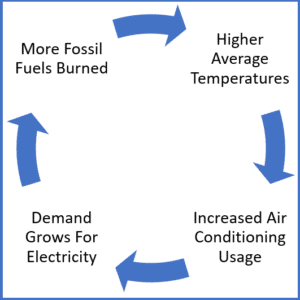As the mercury in your thermometer rises so does your electricity usage. According to the Environmental Protection Agency, the amount of electricity consumed by the average American home during the summer months has nearly doubled over the last fifty years. In 1973 the average American used 735 kilowatt-hours of electricity. By 2020 that figure had surged to 1,384 kilowatt-hours per person. That is equivalent to every American citizen burning 662 pounds of coal or driving a typical vehicle 1,486 miles!

Air conditioning has become the primary way to cool our homes in the United States. Its usage has increased over time and, as of 2015, accounted for 17% of the electricity that the average American household consumes every year. Climate change has led to a horrible cycle where average temperatures are rising, so people use more energy on air conditioning, which causes more greenhouse gas emissions to meet the increased energy demand, which leads to higher temperatures and the cycle starts over again. As of 2018, over 60% of electricity in America was generated by burning fossil fuels such as coal or natural gas. Of course, burning fossil fuels is one of the leading causes of climate change.

There are many things you can do to help lower the carbon footprint of your home. Getting a programable thermostat can give you more control over your heating and cooling while helping to save you money on your energy bills. Installing weatherstripping, caulking, insulation and LED lighting can also make you home more energy efficient. Purchasing ENERGY STAR rated appliances and keeping them well maintained is another way to lower your household carbon emissions.
It is also possible to reduce your carbon footprint through the use of Carbon Offsets. An offset through Carbonfund will help you reduce your impact on the planet. A Household Carbon Offset is specifically targeted at mitigating the emissions generated based on the square footage of your home. This is an excellent way to neutralize the carbon footprint created by your seasonal heating and cooling needs.
Carbonfund provides these offsets by supporting carbon reduction projects all over the world. They have supported more than 240 projects in 28 countries and 42 American states. The types of projects that Carbonfund supports are Renewable Energy, Forestry and Energy Efficiency. These projects have helped Carbonfund offset over 40 billion pounds of carbon emissions. They have also planted over 1.6 million trees in an effort to protect forests by fighting deforestation.
